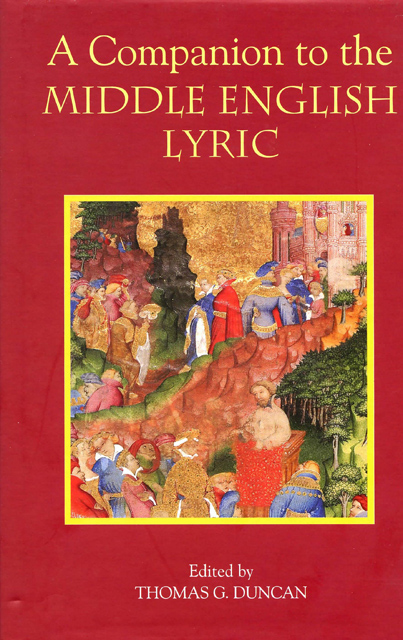Book contents
- Frontmatter
- Contents
- Acknowledgements
- Abbreviations
- Editorial Note
- Introduction
- 1 Middle English Lyrics and Manuscripts
- 2 Middle English Lyrics: Metre and Editorial Practice
- 3 The Love Lyric before Chaucer
- 4 Moral and Penitential Lyrics
- 5 Middle English Religious Lyrics
- 6 Middle English Courtly Lyrics: Chaucer to Henry VIII
- 7 The Middle English Carol
- 8 Political Lyrics
- 9 The Lyric in the Sermon
- 10 ‘Cuius Contrarium’: Middle English Popular Lyrics
- 11 Gender and Voice in Middle English Religious Lyrics
- 12 Lyrics in Middle Scots
- Bibliography of works cited
- Index of Manuscripts Cited
- General Index
- Index of Lyrics
12 - Lyrics in Middle Scots
Published online by Cambridge University Press: 23 March 2023
- Frontmatter
- Contents
- Acknowledgements
- Abbreviations
- Editorial Note
- Introduction
- 1 Middle English Lyrics and Manuscripts
- 2 Middle English Lyrics: Metre and Editorial Practice
- 3 The Love Lyric before Chaucer
- 4 Moral and Penitential Lyrics
- 5 Middle English Religious Lyrics
- 6 Middle English Courtly Lyrics: Chaucer to Henry VIII
- 7 The Middle English Carol
- 8 Political Lyrics
- 9 The Lyric in the Sermon
- 10 ‘Cuius Contrarium’: Middle English Popular Lyrics
- 11 Gender and Voice in Middle English Religious Lyrics
- 12 Lyrics in Middle Scots
- Bibliography of works cited
- Index of Manuscripts Cited
- General Index
- Index of Lyrics
Summary
The medieval vernacular lyric in Scotland exhibits many points of similarity with its English counterpart; this is only to be expected, given the many points of contact in the history of the two countries, the mutual intelligibility of the two languages, and the fact that English and Scottish poets were receptive to the same external cultural influences – from (Anglo-) French and, especially, Latin. Furthermore, the two countries had in common several institutional factors which significantly facilitated literary production: these included a court culture open to influences from France and Burgundy, a church-led educational system, and a network of mendicant houses with a programme of evangelisation directed towards the population at large. On the other hand, many differences between the two traditions are also evident, the most obvious being the fact that Middle Scots literature is so late in starting (c.1375). Moreover, it is not only in its smaller comparative total volume that the corpus of Middle Scots lyrics differs from that of England, but also in its range of topics, the nature of its textual preservation, and its literary character. As will be argued below, the most notable Scottish specimens display a level of stylistic sophistication which transcends what is normally considered most characteristic of the medieval English lyric. Consequently, it is better to consider the Middle Scots lyrics not so much as a tardy, northern extension of the Middle English tradition, but rather as an independent and parallel development from a common cultural base.
Textual intertraffic
There were many opportunities for texts to be passed between the two kingdoms. This might happen, for example, on the occasion of diplomatic and ecclesiastical contacts, whether occurring at home, in the capital cities of neighbouring countries, or at the papal court at Rome. Moreover, in an age addicted to the tournament, knights often travelled widely between centres of chivalry, expanding their acquaintance among the members of the francophone social elite, and helping in the transmission of courtly literature. Students, with their command of the international language of learning, Latin, were also active travellers with literary interests. Dynastic marriages, such as those between James I and Joan Beaufort (1424) and James IV and Margaret Tudor (1503), had important implications for cultural contact.
- Type
- Chapter
- Information
- A Companion to the Middle English Lyric , pp. 242 - 262Publisher: Boydell & BrewerPrint publication year: 2005
- 1
- Cited by



